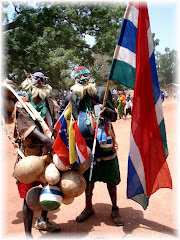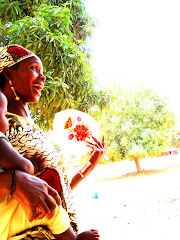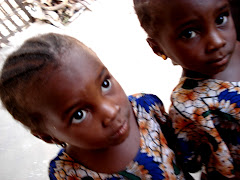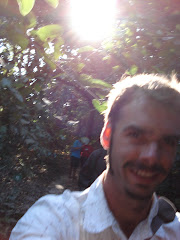 So I got this blister on my thumb. It happened while helping my host brother Landing thresh the groundnuts that he harvested while I was in Guinea.
So I got this blister on my thumb. It happened while helping my host brother Landing thresh the groundnuts that he harvested while I was in Guinea. Groundnuts are brought from the field on donkey carts and then piled in a place well-protected from hungry livestock who love the hay. The plants dry in the sun for a few days and then they are beaten with bamboo canes until the nuts fall from the roots.
Groundnuts are brought from the field on donkey carts and then piled in a place well-protected from hungry livestock who love the hay. The plants dry in the sun for a few days and then they are beaten with bamboo canes until the nuts fall from the roots.
The hay is stacked and will be sold to local herdsmen who will feed it to their livestock as the dry season makes wild plants unavailable. Groundnut hay is of higher monetary value than the nuts.

Threshing can only be done during the warmest part of the day when the sun is shining very hot. One bamboo cane is used for lifting the plants while the other is for beating. You can kick them a little to separate them. Landing said that I would soon be "qualified." I made twelve blisters on my palms and three on my thumbs. The one on the right thumb became infected. Maybe a splinter went in or possibly germs and weebeasties. My doctor from Sierra Leone told me that.
 Groundnuts can also be harvested by hand. My host father loves groundnuts. One of my favorite things about groundnut harvesting season: While the legumes are still attached to the roots, the dry plants can be set ablaze.
Groundnuts can also be harvested by hand. My host father loves groundnuts. One of my favorite things about groundnut harvesting season: While the legumes are still attached to the roots, the dry plants can be set ablaze. Once the plants are burned, we sit in the dirt and eat roasted nuts until our teeth are blackened.
Once the plants are burned, we sit in the dirt and eat roasted nuts until our teeth are blackened.
Harvesting is happening everywhere these days. The cool season is upon us and people are staying very busy. My rice field produced a nice harvest. From the four kilos we planted, we harvested almost thirty five which is a great return. We didn't even use fertilizer.
 The rice is cut from the grass and then brought back to the village in bundles carried on the head.
The rice is cut from the grass and then brought back to the village in bundles carried on the head. My friend Malang Manjang is an exceptional farmer. He planted fields of millet, corn, beans, sorghum, and sesame this year. The sesame plants produce beautiful flowers.
My friend Malang Manjang is an exceptional farmer. He planted fields of millet, corn, beans, sorghum, and sesame this year. The sesame plants produce beautiful flowers. Most of the folks I loaned rice to returned it to me once they harvested. Now I have over 100 kilos and I will save about fifty for planting next year.
Most of the folks I loaned rice to returned it to me once they harvested. Now I have over 100 kilos and I will save about fifty for planting next year.
I also have been harvesting other crops. I tried planting mung beans and had a decent harvest. Remember when I first started A Growing Sense and wanted to become Duke City's King of Sprouts? I bought mung beans and let them grow for two or three days and then sold them at farmer's markets. People loved them.
 I also have been experimenting with growing a few other things. Tomatoes are much loved here but wilts, blights, mosaics, and nematodes usually destroy the plants before they can produce fruit. I heard that tomatoes can be grafted to eggplants which do not suffer from such problems.
I also have been experimenting with growing a few other things. Tomatoes are much loved here but wilts, blights, mosaics, and nematodes usually destroy the plants before they can produce fruit. I heard that tomatoes can be grafted to eggplants which do not suffer from such problems. But I don't really know if the plants will produce fruit. We'll wait and see.
But I don't really know if the plants will produce fruit. We'll wait and see.I've been spending a lot of time at the NBAG apiary in Nyambai.

We are trying to correct the bees tendency to build combs across the top-bars rather than one on each. The cross-combing is a big problem here.
 The process we are developing involves cutting the combs off of the bars.
The process we are developing involves cutting the combs off of the bars. And then tying them on to individual bars. We have switched to wire instead of cloth because the bees accept it more readily.
And then tying them on to individual bars. We have switched to wire instead of cloth because the bees accept it more readily.
I went on an overnight boat ride on the Bintang Bolong. This is a small tributary of the River Gambia that is located near my home.
 Tim, Jeff, Alex, and I borrowed dug out canoes called pirogues from local fishermen and set out.
Tim, Jeff, Alex, and I borrowed dug out canoes called pirogues from local fishermen and set out. I let Jeff paddle me because my thumb was throbbing. It was still just a blister at this point but I was becoming a little worried. It was painful and had swelled to twice the size of the other.
I let Jeff paddle me because my thumb was throbbing. It was still just a blister at this point but I was becoming a little worried. It was painful and had swelled to twice the size of the other.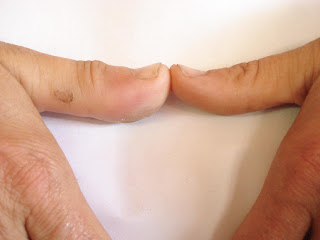 But the river was calm and very pretty. We had a relaxing time watching birds and listening to river sounds. There were pelicans and king fishers and hawks.
But the river was calm and very pretty. We had a relaxing time watching birds and listening to river sounds. There were pelicans and king fishers and hawks.
Because of its proximity to the Atlantic, the Bintang Bolong is tidal. When we started out we went around in circles because we were paddling against the flow. The pirogues are made from carved trees and tend to be a little wonkity in the river. Maybe it is just us: Gambians stand in them and throw nets and seem to do just fine. Jeff and I caused our boat to capsize while bailing water out with a small cup. We flooded and sank. The current was fast and we struggled to pull the canoe to shore. Jeff pulled at the boat and swam while I kept hold of our bags and the twenty liter bidong of fresh water we had for the overnight trip. It took about ten minutes to get everything to shore. Jeff's fishing pole sunk and I watched my camera in its plastic case float away. I ran down the beach cutting my feet on shells while stripping my heavy, soaked clothes to get ahead of it. I jumped in and swam out and saved it from the fast current. The case was water-tight and so the camera still works. It makes pictures like this one.
 We camped on a serene little beach where we drank wine and ate canned meat. The next day we caught the tide and floated home.
We camped on a serene little beach where we drank wine and ate canned meat. The next day we caught the tide and floated home. When I arrived in my village I found that my duck had died.

I was saving that one for my parents' visit next week but now they will just have to have monkey meat, scrawny chickens, and billy goat. Also, my headlamp got wet when we capsized and the salt water ruined it. I had had that light for years and it has illuminated many New Mexican cacti and Arizonan coyotes and Gambian fruitbats. Now the only light I have by which to read at night is this locally-bought pen-light on the end of a disposable lighter. For some reason though, it casts an image of Saddam Husein which is discomforting to read by.

My thumb had continued to get worse. The blister began to ripen and turn black. I could feel my heart pumping like it wanted to explode the tip off. The pain was all the way to my elbow. I was scheduled to help train the new Volunteers who were at Tendaba Camp in Kiang. I rode my bike there and expected to find the Peace Corps nurse but she was still two days away. I called her and she started me on antibiotics and recommended hot water soaks.
 The thing about helping with the Training is that it takes you full circle. These kids are where I was one year ago and it brought my service into perspective. I have learned a lot here and was happy to share some of that wisdom with these fresh faced (no sun-wrinkles) and idealistic (not jaded by the realities of development work) kids. It also gave me a chance to see how the tourist art at Tendaba Camp has transformed.
The thing about helping with the Training is that it takes you full circle. These kids are where I was one year ago and it brought my service into perspective. I have learned a lot here and was happy to share some of that wisdom with these fresh faced (no sun-wrinkles) and idealistic (not jaded by the realities of development work) kids. It also gave me a chance to see how the tourist art at Tendaba Camp has transformed. Above is the mural from November 2007 while below is the bustier one there now.
Above is the mural from November 2007 while below is the bustier one there now.
The nurse arrived at Tendaba and was quite impressed with my blister. Although I had already lanced it once with a sewing needle, she gave it another shot using a syringe. Unfortunately, it was unproductive as the pus was too thick to be aspirated in such a fashion. Also, it hurted.
We went back to Kombo and on Thanksgiving morning the darn thing was ripe as a plum and burning like hell-fire.
 The nurse called the doctor. He works for the United Nations and so doesn't need the day off. He doesn't really care about pilgrims and cornucopias and turkeys. He thought that maybe there was some sort of foreign body in there like maybe a splinter from a bamboo cane or some bacteria from eating groundnuts that had been cooked in the dirt. Anyway, why not cut it open?
The nurse called the doctor. He works for the United Nations and so doesn't need the day off. He doesn't really care about pilgrims and cornucopias and turkeys. He thought that maybe there was some sort of foreign body in there like maybe a splinter from a bamboo cane or some bacteria from eating groundnuts that had been cooked in the dirt. Anyway, why not cut it open?
So that's what he did.
 Getting whatever was in there out of there sure felt better. Now I'm healing.
Getting whatever was in there out of there sure felt better. Now I'm healing.
Also, that mustache looked stupid and so I shaved it.















